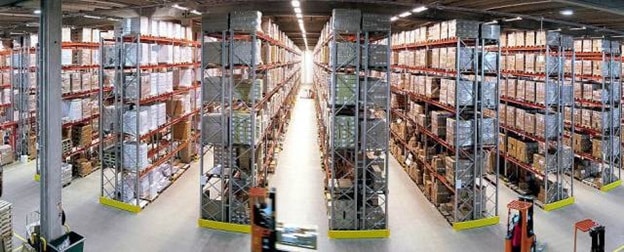Manufacturers, wholesalers, retailers, and any other business that intends to provide physical commodities in bulk will need a warehouse. To put it simply, a warehouse is a storage capacity, which serves the stocking needs of a business. Depending upon the nature of the business and each organisation’s individual requirements, the following are the different types of warehouse layout structures one could choose from:
It is important that you acquaint yourself with the concept of each of these warehouse structures to choose the best for your business.
Pallet Racking
Pallet racking is primarily used for items that are stocked in boxes and shipped frequently. Depending upon the weight of the stock and its size, you could use pallets made of wood, plastic, or metal. Pallet racking also needs a considerate aisle space to ensure hassle-free movement of items coming in or going out for delivery. However, with pallet racking, one mustn’t overlook the weight restrictions. The safety of your warehouse workers and the items stored depends on the sturdiness of the pallets. If over-stored, the racks could dismantle, causing major hazards.
Shelving
Contrary to moving pallets, shelving is a method of stacking items on shelves. Imagine the way a supermarket stores items, different rows for different supplies. Thus, you can understand this method of warehousing works well for items that require manual coordination or precise organization. Items that fall under the category of small and light goods can make the most of shelving.
However, a long span shelving method can also be used for larger items in bulk.
The only thing one needs to be careful about with shelves is the items kept at the top shelf. To access the far-off commodities, a sturdy ladder is needed.
Mobile Shelving
Now imagine a warehouse with the concept of shelving kept intact, however, just add a level trackway to it. The trackways can be laid on the floor or even on the top of the shelves. This allows the warehouse more flexibility as its shelves can now be moved to transport the goods.
However, when the shelves aren’t required to be carried, the tracks can also be locked to keep the shelves fixed in one place. Mobile shelving can be of great help to industries that operate in mechanical parts, wherein transportation is frequent but also a constantly moving storage could lead to broken or lost goods.
Mezzanine Flooring
If your main concern is the surface area of your warehouse, then mezzanine flooring is the way to go! A mezzanine floor allows you to expand the surface of your warehouse with the help of a steady yet portable metal base that can be installed between two of your existing floors.Moreover, one gets plenty of designs and options to choose from in a mezzanine warehouse structure. Relocation is a fairly expensive ordeal and disturbs the routine of your business. With the help of experts such as AW Structures, you could get reasonably priced mezzanine floors installed in no time.
Multi-Tier Racking
Ideal storage facility when you have a bulk of small-sized goods, this allows you to scale up your floor area by adding multiple tiers to your warehouse. It makes use of mezzanine floors and scissor lifts to add partial levels to the facility. The advantage they have over shelving and simple mezzanine flooring are that they allow easy access to goods kept at heights due to the automated lifts’ facility.
These are some of the most commonly used warehouse structures that find themselves being useful for industries ranging from agriculture to petrochemicals. We hope you are now able to answer for yourself on which warehouse structure do you need.

